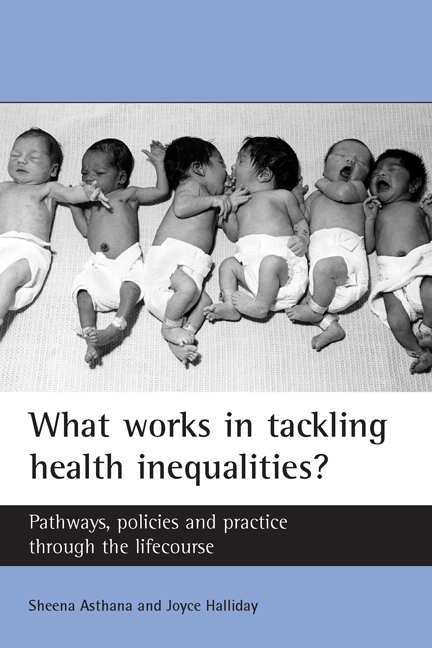Book contents
- Frontmatter
- Dedication
- Contents
- List of tables, boxes and figure
- Acknowledgements
- List of abbreviations
- one Introduction
- Part 1 The research and policy context of health inequalities
- Part 2 Health inequalities pathways, policies and practice through the lifecourse
- Part 3 Tackling health inequalities: developing an evidence base for public health
- Index
seven - Health inequalities during childhood and youth: policy and practice
Published online by Cambridge University Press: 14 January 2022
- Frontmatter
- Dedication
- Contents
- List of tables, boxes and figure
- Acknowledgements
- List of abbreviations
- one Introduction
- Part 1 The research and policy context of health inequalities
- Part 2 Health inequalities pathways, policies and practice through the lifecourse
- Part 3 Tackling health inequalities: developing an evidence base for public health
- Index
Summary
Introduction
There is a paradox, as Chapter Six has shown, between the relative clinical invisibility of young people and high levels of social concern. Youth, allied with drugs, crime and antisocial behaviour, has arguably dominated domestic home affairs in the UK in the 1990s (Parker et al, 1998), with much of the response and the advocacy coming from the margins of health and welfare rather than mainstream medicine. This chapter, although focusing on the two main sources of inequalities in mortality and morbidity for children and young people, that is accidents and mental health, is also located firmly in the arena of health behaviour for it is delinquency, rather than the problems of conduct disorder that often lie at its heart, that has attracted the political profile and hence research attention. Given that delinquency itself is then but part of a larger spectrum of antisocial behaviour, including substance misuse and sexual promiscuity, the links to Chapters Eight and Nine are manifold.
The organisational difficulties consequent on interventions in early life were outlined in Chapter Five. Here, the challenge of assessing what works, for whom and in what circumstances is made yet harder by the age range encompassed. Traditional notions of bounded youth have, as Chapter Six has stressed, been challenged by the increasing delay before the vast majority of adolescents achieve financial and domestic independence. There is thus an extended period post-adolescence where one can no longer assume the existence of adult responsibilities. Arguably this may have some advantages in that the window for tackling childhood disadvantage may widen but chronological age becomes a less reliable guide to policy (Graham and Power, 2004) and, as we noted in Chapter Six, even this extension of childhood is differentiated by class.
Typically, intervention and policy do not accord equal emphasis across the 20 years of childhood and youth. Those focusing on accidents and injuries, together with nutrition, tend to place more emphasis on childhood, while those that focus on mental health, substance misuse and sexual health tend to place more stress on early youth. Few initiatives take late youth as their focus. Indeed, the lack of appropriate services for children in areas such as mental health has long been a cause for concern without the added complication that young people in late adolescence and beyond might also require a differentiated approach.
- Type
- Chapter
- Information
- What Works in Tackling Health Inequalities?Pathways, Policies and Practice through the Lifecourse, pp. 249 - 280Publisher: Bristol University PressPrint publication year: 2006



